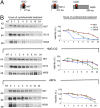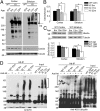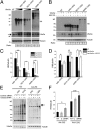Differential ubiquitination and degradation of huntingtin fragments modulated by ubiquitin-protein ligase E3A
- PMID: 24706802
- PMCID: PMC3992696
- DOI: 10.1073/pnas.1402215111
Differential ubiquitination and degradation of huntingtin fragments modulated by ubiquitin-protein ligase E3A
Abstract
Ubiquitination of misfolded proteins, a common feature of many neurodegenerative diseases, is mediated by different lysine (K) residues in ubiquitin and alters the levels of toxic proteins. In Huntington disease, polyglutamine expansion causes N-terminal huntingtin (Htt) to misfold, inducing neurodegeneration. Here we report that shorter N-terminal Htt fragments are more stable than longer fragments and find differential ubiquitination via K63 of ubiquitin. Aging decreases proteasome-mediated Htt degradation, at the same time increasing K63-mediated ubiquitination and subsequent Htt aggregation in HD knock-in mice. The association of Htt with the K48-specific E3 ligase, Ube3a, is decreased in aged mouse brain. Overexpression of Ube3a in HD mouse brain reduces K63-mediated ubiquitination and Htt aggregation, enhancing its degradation via the K48 ubiquitin-proteasome system. Our findings suggest that aging-dependent Ube3a levels result in differential ubiquitination and degradation of Htt fragments, thereby contributing to the age-related neurotoxicity of mutant Htt.
Keywords: misfolding; proteolysis.
Conflict of interest statement
The authors declare no conflict of interest.
Figures







Similar articles
-
Herp Promotes Degradation of Mutant Huntingtin: Involvement of the Proteasome and Molecular Chaperones.Mol Neurobiol. 2018 Oct;55(10):7652-7668. doi: 10.1007/s12035-018-0900-8. Epub 2018 Feb 12. Mol Neurobiol. 2018. PMID: 29430620
-
Degradation of mutant huntingtin via the ubiquitin/proteasome system is modulated by FE65.Biochem J. 2012 May 1;443(3):681-9. doi: 10.1042/BJ20112175. Biochem J. 2012. PMID: 22352297
-
Atypical ubiquitination by E3 ligase WWP1 inhibits the proteasome-mediated degradation of mutant huntingtin.Brain Res. 2016 Jul 15;1643:103-12. doi: 10.1016/j.brainres.2016.03.027. Epub 2016 Apr 21. Brain Res. 2016. PMID: 27107943
-
Huntingtin Ubiquitination Mechanisms and Novel Possible Therapies to Decrease the Toxic Effects of Mutated Huntingtin.J Pers Med. 2021 Dec 6;11(12):1309. doi: 10.3390/jpm11121309. J Pers Med. 2021. PMID: 34945781 Free PMC article. Review.
-
Strategies to Investigate Ubiquitination in Huntington's Disease.Front Chem. 2020 Jun 11;8:485. doi: 10.3389/fchem.2020.00485. eCollection 2020. Front Chem. 2020. PMID: 32596207 Free PMC article. Review.
Cited by
-
Pathological Involvement of Protein Phase Separation and Aggregation in Neurodegenerative Diseases.Int J Mol Sci. 2024 Sep 23;25(18):10187. doi: 10.3390/ijms251810187. Int J Mol Sci. 2024. PMID: 39337671 Free PMC article. Review.
-
The struggle by Caenorhabditis elegans to maintain proteostasis during aging and disease.Biol Direct. 2016 Nov 3;11(1):58. doi: 10.1186/s13062-016-0161-2. Biol Direct. 2016. PMID: 27809888 Free PMC article. Review.
-
Deubiquitinase Usp12 functions noncatalytically to induce autophagy and confer neuroprotection in models of Huntington's disease.Nat Commun. 2018 Sep 28;9(1):3191. doi: 10.1038/s41467-018-05653-z. Nat Commun. 2018. PMID: 30266909 Free PMC article.
-
Altered Levels of Long NcRNAs Meg3 and Neat1 in Cell And Animal Models Of Huntington's Disease.RNA Biol. 2018;15(10):1348-1363. doi: 10.1080/15476286.2018.1534524. Epub 2018 Oct 26. RNA Biol. 2018. PMID: 30321100 Free PMC article.
-
Ubiquitin, Autophagy and Neurodegenerative Diseases.Cells. 2020 Sep 2;9(9):2022. doi: 10.3390/cells9092022. Cells. 2020. PMID: 32887381 Free PMC article. Review.
References
-
- Gusella JF, MacDonald ME, Ambrose CM, Duyao MP. Molecular genetics of Huntington’s disease. Arch Neurol. 1993;50(11):1157–1163. - PubMed
-
- Snell RG, et al. Relationship between trinucleotide repeat expansion and phenotypic variation in Huntington’s disease. Nat Genet. 1993;4(4):393–397. - PubMed
-
- Kuemmerle S, et al. Huntington aggregates may not predict neuronal death in Huntington’s disease. Ann Neurol. 1999;46(6):842–849. - PubMed
-
- Vonsattel JP, DiFiglia M. Huntington disease. J Neuropathol Exp Neurol. 1998;57(5):369–384. - PubMed
-
- DiFiglia M, et al. Aggregation of huntingtin in neuronal intranuclear inclusions and dystrophic neurites in brain. Science. 1997;277(5334):1990–1993. - PubMed
Publication types
MeSH terms
Substances
Grants and funding
LinkOut - more resources
Full Text Sources
Other Literature Sources
Molecular Biology Databases

